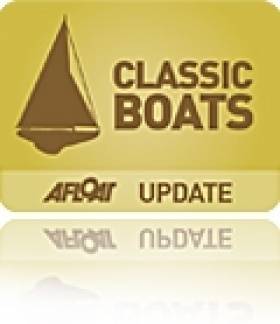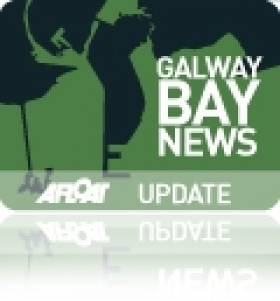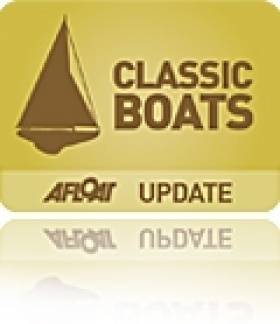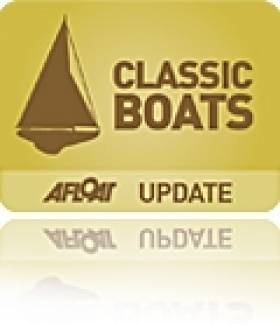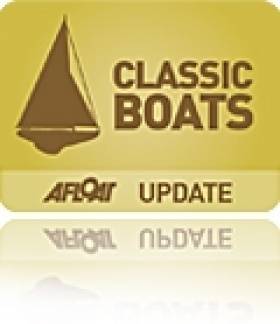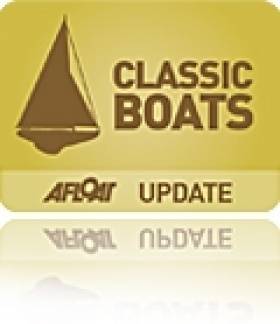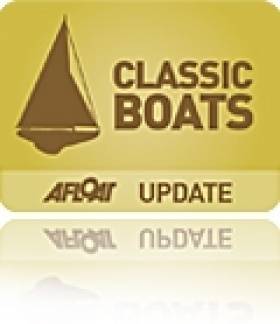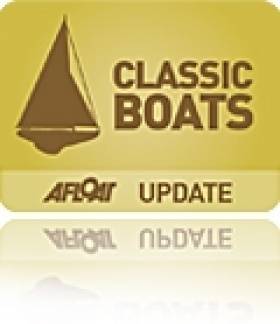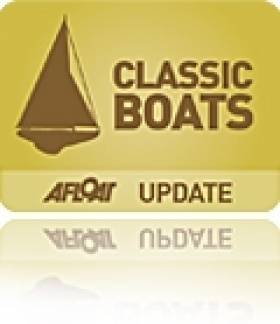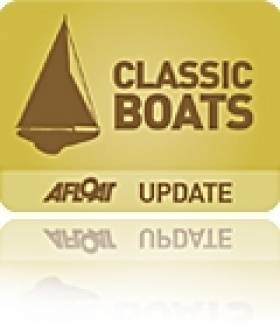Displaying items by tag: Historic Boats
#NaomhÉanna - Minister for Heritage, Jimmy Deenihan and Waterways Ireland have agreed to restrain the scrapping of the nation's oldest surviving merchant ship, Naomh Éanna until next week, while a campaign group arrange a survey as previously reported on Afloat.ie, to determine her true condition.
The Save Our Ship (SOS) Naomh Éanna campaign group had sought a target of €15,000 in funds which were raised through social media so to dry dock the iconic vessel and determine the structural integrity of the hull's condition.
The vessel completed in Liffey Dockyard in 1958, is moored in the number 2 graving dock in Grand Canal Dock, Dublin Port and the group are under pressure to have all arrangements made to pump out the dock.
In addition they are to chock the vessel so surveyors can access the critical shallow bottom ballast tanks where her frames and keel could have deteriorated.
Should the frames and keel be wasted to the extent that they need replacing then the vessel would be deemed un-economic to restore unless supported by the state as is common in most developed countries, according to the campaigners.
Waterways Ireland would then instruct their contractors L&M Keatings to destroy the ship.
The Minister and Waterways Ireland have made it very clear they will not assist or absorb any expense relating to this survey. Disregarding her status as the Nation's oldest surviving merchant vessel, her connection to Dublin's ship building heritage and her 30 year service between Galway to the Aran Islands.
She represents historic and cultural ties of island life during a career that many people fondly recall sailing on her, though the Underwater Archeological Unit have declared that she has 'no heritage value whatsoever'.
The SOS group dispute this finding as the European industrial heritage directive dictates any industrial artifact over 25 years old is deserving of protection.
The group also points out the employment potential of such an attraction in Galway Harbour (where a berth is available to her). Her proposed use as a multi-purpose floating venue after restoration would consist of boutique hostel, restaurant, cafe, micro-brewery and museum expects to employ more than 45 people.
Should the group manage to organise the dry docking and ascertain she is salvageable following survey due on 7 May, they are determined to negotiate the transfer of the vessel to a holding company.
This company will work on arranging private finance to restore and refit the ship in Dublin in line with the business plan presented to Minister Deenihan in April. Following repairs they are optimistic she will be able to sail under her own steam to Galway for completion.
Another historic vessel, Mary Stanford that had shared company with Naomh Eanna in Dublin's Grand Canal Dock, returned last weekend to her 'spiritual home' of Ballycotton. Co. Cork, where she is to be restored to glory.
The Barnett-class lifeboat was was renowned for her daring role in the rescue of the Daunt Rock lightship's crew in 1936. For the last two decades there has been a campaign to save her which eventually led to her been hoisted out of the basin in March.
Initially she taken by road to a warehouse in Midleton and last weekend she finally completed her journey to east Cork as the Irish Examiner reported and that of her next stage of restoration.
Public Lecture On Galway's Historic Boats This Weekend
#GalwayBay - If you're in Galway this weekend be sure to check out a public lecture by Cóilín Ó hIarnáin on the City of the Tribes' historic working boats of the 19th century.
As the Galway Advertiser reports, there's more to the city than the iconic Galway Bay Hooker, as the likes of the Scottish Zulu and the Manx Nobby were commonplace in local waters.
Details for booking a place at this free talk at the Galway City Museum this Saturday 12 April are available HERE.
#NaomhÉanna – Marine restoration specialists Irish Ship & Barge Fabrication Co in co-operation with the Naomh Éanna Trust's Save Our Ship (SOS) campaign group are to present a €1.86m business plan today to Heritage Minister, Jimmy Deenihan.
As previously reported on Afloat.ie, the minister had called for a 'concrete business plan' and today's presentation of the business plan will be using private funds to restore Ireland's oldest surviving merchant vessel, the former Aran Islands passenger, freight and cattle-carrying ferry.
The group need the minister to intervene and halt the scrapping by Waterways Ireland of the Liffey Dockyard ship completed in 1958 as the reprieve date expires next Monday, 31 March.
The plan was prepared in only 4 weeks and proposes a number of commercial activities on board the Naomh Éanna after restoration: a 82-bed boutique hostel, a 46-seat restaurant, an interactive museum and a micro-brewery plus a café seating 60 people.
Galway Port Company have offered a berth for the restored Naomh Éanna in which CIE had operated the 137ft vessel on the three-hour service to the Aran Islands until 1988. She then sailed to Dublin Port and in the following year she was transferred to the Irish Nautical Trust and berthed in Grand Canal Basin.
The plan describes how the vessel could be repaired in a dry dock in Dublin. Engineers are confident the antique machinery in the ship can be returned to service and the ship will return to her home city under her own steam.
#NaomÉanna- Lorna Siggins of The Irish Times writes that Minister Jimmey Deenihan at the Department of Arts, Heritage and Gaeltacht has said that any proposal to save the former Aran island ferry Naomh Éanna will have to include a "concrete business plan".
Mr. Deenihan has put a four-week stay on plans by Waterways Ireland to break up the ferry, and had agreed to meet representatives of the campaign seeking to have the ship saved.
The ferry, which once carried passengers such as James Joyce Ulysses publisher Sylvia Beach and writer Brendan Behan on its regular runs between Galway and the Aran islands, is in dry dock in Dublin's Grand Canal basin, awaiting dismantling.
However, Inland Waterways Association of Ireland ship restorer Sam Field Corbett and a number of public officials believe the vessel as previously reported on Afloat should be saved and refurbished.
As previously reported on Afloat.ie, there are proposals to move the veteran vessel to her old homport of Galway and become a floating maritime museum and form a focal point as part of plans to re-develop the inner harbour.
Famous Lifeboat Completes 12-Hour Overnight Road Journey
#MaryStanford – Former lifeboat RNLB Mary Stanford was hoisted out of the Grand Canal Dock Basin, Dublin and onto a road-trailer at the weekend, writes Jehan Ashmore.
The 51ft class Barnett-class lifeboat completed the overnight 12-hour road journey to Midleton, Co.Cork.
She was made famous for the rescue of the Daunt Lightship crew in 1936 and as previously reported made her final farewell on Saturday in the Ringsend basin, albeit on the short-hop from Charlotte Quay to the slipway.
On board her last hurrah were relatives of the coxswain, Colm and Aidan Sliney aswell as the nationwide crew.
From working on her getting her ready for the lift it was clear to see she is made of hardy stuff.
The raising of the boat was witnessed by the local community and to whom also lifted the spirits of the occasion.
At 4pm the crane took over making the transition from sea to land seem effortless thanks to skilful operator and the loading onto the truck. Her journey saw her safely delivered 12 hours later into the early hours of Sunday.
With support of a campaign, she is to be restored and located on a plinth overlooking the coastal path at Ballycotton, to where she was stationed with the RNLI. With a little love the Mary Stanford will out-live us all.
#NaomÉanna- According to Galway Bay FM, Galway Port Company said it would be happy to provide a permanent home for an old ferry, Naom Éanna, which once linked Galway to the Aran Islands.
The port's harbourmaster, Captain Brian Sheridan says Galway docks would be an ideal location for the Naomh Éanna as a tourist attraction.
Gaeltacht Minister Jimmy Deenihan has put a stay on scrapping the Naomh Eanna until the end of March.
The vessel has been housed at Dublin's Grand Canal, but a proposal was put forward to scrap it, which is being opposed by the Inland Waterways Association of Ireland and other maritime groups.
Among the campaigning groups are the Naomh Éanna Trust's SOS Save Our Ship which in co-operation with Sam Field-Corbett of the Irish Ship & Barge Fabrication Co, are hoping for funding from private investors, so to save the vessel from scrapping by Waterways Ireland.
Due to the reprieve date of less than four-weeks to go this month, Stephen Payne of the Naomh Eanna Trust also speaking to Galway Bay FM, has said that the IS&BF would not be able to secure a berth for her in the Dublin Port for at least the next two years.
It is proposed instead to sail the vessel under own steam to Galway Port, this would involve spending €180,000 to bring her to a seaworthy state. Mr. Payne added the engines were in working order.
To completely carry out a full restoration to her former glory would be in the region of €1.8m to €2m.
Afloat.ie adds that the trust's SOS Save Our Ship campaign's online petition to save the heritage ship at time of posting stands at more than 300 signatures.
Hopes ‘Raised’ for former Lifeboat’s Saving yet Lack of Reprieve Time for Naom Éanna, Campaigners Claim
#HeritageVessels – Following Afloat.ie's weekend coverage of the removal of former RNLB Mary Stanford from Dublin's Grand Canal Dock Basin in Ringend from where she was loaded onto a lorry bound for her original homeport of Ballycotton, further updates will be made in following the progess of her restoration project.
The Barnett-class lifeboat which rescued all 6-crew of the Daunt Rock lightship in 1936 is to relocated to a new plinth overlooking the sea at the East-Cork location. In addition the campaigners of the Mary Standford Project are seeking donations to restore the vessel to her former glory.
During the lifeboat's hoisting operation which involved her removal by the slipway next to the Naom Éanna, the historic heritage ship that once served the Galway-Aran Islands ferry service until she was withdrawn in 1988. She retired to Dublin where she was recently moved from her berth to a nearby graving dock (see photo).
The 1958 built vessel said to be "one of the last riveted ships built in the world" was granted a one-month reprieve to save her from the shipbreakers-torch, following an intervention of the Seanad.
As reported today, campaigners have expressed disappointment at what they claim is too short a stay of execution for the 137ft vessel.
Sam Field Corbett, of the SaveOurShip campaign and marine heritage restoration business Irish Ship & Barge Fabrication, said it had been made clear before last week's debates in Leinster House that 16 weeks would be required to prepare such a plan "involving no State funding".
In the meantime, an online petition has been launched to urge Government to extend the Naomh Éanna's life beyond the present 31 March deadline.
#NaomÉanna- An online petition by campaigners has been set-up to save Naom Éanna, the former CIE Galway-Aran Islands ferry which faces scrapping by Waterways Ireland, as the date for her reprieve expires on 31 March, writes Jehan Ashmore.
Last week Sinead Eirean granted a stay of execution to scrap the Liffey Dockyard built vessel dating from 1958 and despite Minister Deenihan of the Department of Arts & Heritage and the Gaeltacht, who had rejected an appeal to save the 438 tonnes veteran vessel.
Naom Éanna is the oldest surviving example of an Irish ship built using riveted-hull construction techniques and as such she holds a unique position in the nations shipbuilding heritage. In addition she served as a vital passenger and cargo link for the Aran Islanders and the mainland and a cultural identity that campaigners also wish to recognise.
Among those campaigning have been the Naomh Éanna Trust, the Inland Waterways Association of Ireland and the Irish Ship & Barge Fabrication Company. Sam Field Corbett of the company has called for time so to implement a business plan in attracting private investment so to facilitate her restoration.
For more than a week, Naom Éanna has been berthed at a graving dry-dock owned by NAMA at the Grand Canal Dock Basin. The 137ft veteran vessel had been berthed at Charlotte Quay, her long-standing location in the basin for more than a quarter century.
Following withdrawal from Galway Bay service in 1988 she sailed to Dublin Port. The following year she was taken over by the Irish Nautical Trust and taken to her Ringsend home where marine-related businesses were based on board.
Department of Arts & Heritage Rejects Appeal to Save Naom Éanna
#NaomEanna – The campaign to save the Ballycotton Lifeboat is secure however the fate of former Aran Islands ferry Naomh Éanna despite support of some T.D.'s to save her is according to The Irish Times rejected by the Department of Arts, Heritage and the Gaeltacht as the vessel is due to be broken up by Waterways Ireland.
The department said that "the decision has not been taken lightly", but is "necessary because of the continuing serious risk posed by the vessel", which has been in Dublin's Grand Canal Basin for almost 30 years.
The ship, built in Dublin's Liffey Dockyard in 1956, served the Galway to Aran island sea route for 30 years, before being acquired from State owner CIÉ by the Irish Nautical Trust. It was laid up in 1986.
Famous Ballycotton Lifeboat Saved Leaves Fate of Naom Éanna Open to Dáil Questions?
#FamousLifeboat – Former Ballycotton RNLB lifeboat, Mary Stanford, arguably the most famous vessel to serve the institution, is due to return 'home', following years of neglect in Dublin's Grand Canal Dock, leaving the fate of Naom Éanna much to be desired, writes Jehan Ashmore.
On Wednesday, Naom Éanna, the former Galway-Aran Islands ferry built by Liffey Dockyard in 1958 for the CIE operated service, was moved by Waterways Ireland on foot of safety concerns should the veteran vessel spring a leak and sink in the basin. Such a situation potentially poses health, safety risks not to mention a navigation obstacle that could hinder notably the Viking Splash Tours amphibious excursion craft entering the basin.
As for the Mary Stanford, her fate is finally secured after two decades in attempting to restore her, following the establishment of a committee that began in October 2013 which has successfully raised funds in acquiring the 51ft Barnett-class lifeboat.
In mid-March she is due to be transported by road to Ballycotton on Cork's southern coastline, where she made history in rescuing the crew of the Daunt lightship in 1936. The 60-hour ordeal that took place on 11 February, 78 years ago, would became the first and only lifeboat in RNLI history to have been awarded a gold medal for gallantry, that is for the boat herself, as well as her crew who were recognised for their bravery.
The Gold medal was awarded to Coxwain Patrick Sliney, a grandfather of Colm Sliney who is involved in the campaign to bring her home. The silver and bronze medals were also presented to the rest of the crew at a ceremony held in London and notably attended by Duke of Kent, who would later abdicate as King Edward VII. A photograph of the event depicts the Duke chatting to some of the lifeboat crew as published in the Cork Examiner of the time, see the Facebook page for Save the Mary Stanford.
On the return of Mary Stanford to Munster, the boat will be raised on a plinth near the entrance to the Ballycotton Cliff walk and may need to be covered during her restoration. The cruiser-stern boat has mahogany decks surrounding her superstructure constructed on a double-diagonal planked hull.
During her career between 1930 and 1959, she was called out on 41 'shouts' resulting in the saving of 122 lives. In order to carry out this second stage of the restoration project, further fundraising is required and the committee have also set up a website to the lifeboat that saved so many lives!
At one stage, the lifeboat beame a pilot cutter for Limerick Harbour Commissioners before eventually ending up in the Grand Canal Basin, from where until recently she was moored alongside Naom Éanna. Noting, this is how her name is spelt (as to distinct to Naomh with a 'h'), and port of registry, Gallim, using Gaelic traditional script which can be barely be seen when viewed from the basin as the stern of the vessel remains exposed in the graving dock.


























